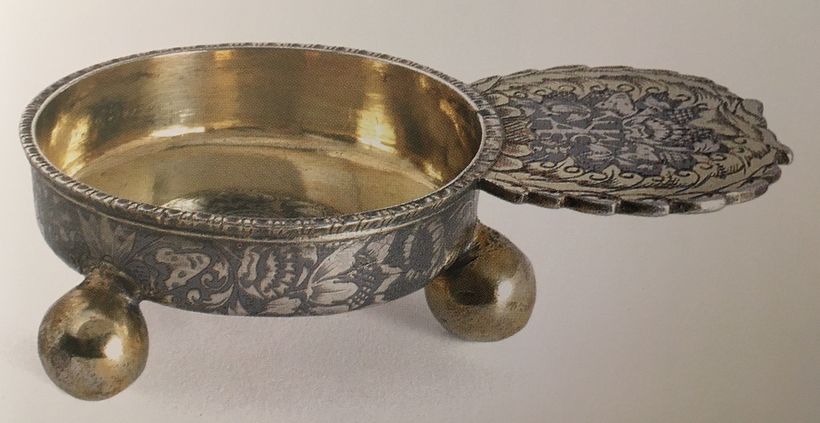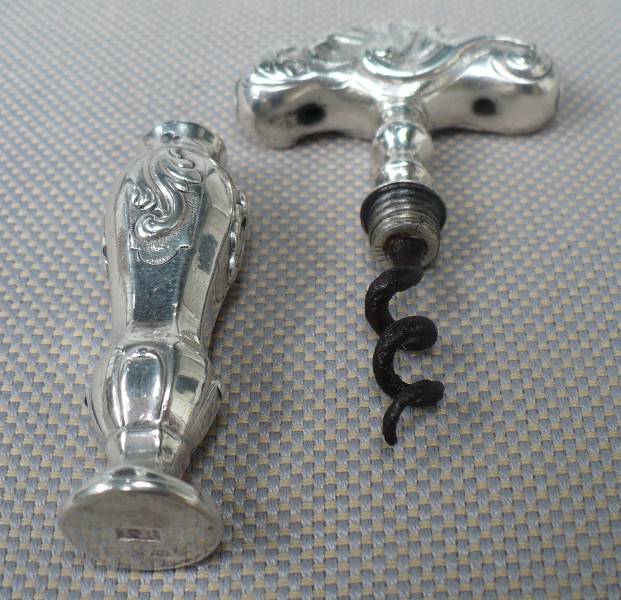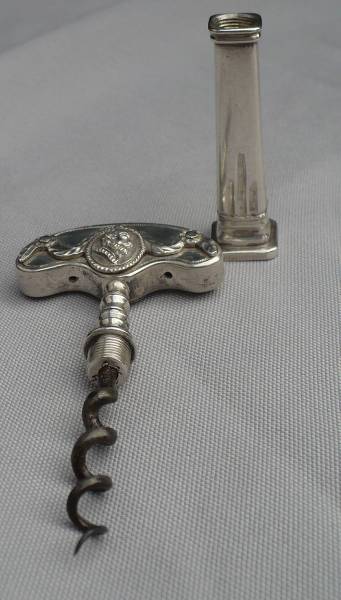Page 1 of 1
Niello? Ashtray?
Posted: Thu Apr 06, 2023 9:50 am
by GiulyF
Hy all
I don't recognize the assayer of this, in my opinion, silver and niello ashtray.
The town mark is for Moscow.
thanks for the usual thank you for the usual professionalism and competence that I find in every answer.


Re: Niello? Ashtray?
Posted: Thu Apr 06, 2023 10:02 am
by Mart
There is no silversmith's mark here. This is an assay institution of the city of Tiflis (Tbilisi)
Re: Niello? Ashtray?
Posted: Thu Apr 06, 2023 10:20 am
by GiulyF
Mart wrote: ↑Thu Apr 06, 2023 10:02 am
There is no silversmith's mark here. This is an assay institution of the city of Tiflis (Tbilisi)
Dear Mart, yep ther's no silversmith mark on it, so the assayer could be Igor Blyumberg (1841-1886) from Tiflis, forgive the writing.
I was convinced it was a fly because I didn't find a match with Tiflis.
Can I call it an ashtray or did it have another function/term in Russian culture and life?
Re: Niello? Ashtray?
Posted: Thu Apr 06, 2023 11:40 am
by Mart
The product was made in the Caucasus. This is a region with its original wonderful culture and very tasty food))) I'm not sure if this is an ashtray. I think that the forum members will tell you better. Good luck!
Re: Niello? Ashtray?
Posted: Thu Apr 06, 2023 12:10 pm
by Silverstone
Dear GiulyF,
your cup is a „
charka“.
Чapкa
Charka (charki)
A small vessel for strong drink, especially widespread in the 17th-18th centuries.
I can show you a similar one from Veliki Ustiug, ca. 1770.
Circular, on three feet, the centre and body decorated with niello, stylised motiv of the „Tree of Live“ within chased and engraved foliate border, apparently unmarked.
l 98 mm / w 66 mm / h 28 mm / gr 80,6 / ml 43

Source: Charka, The russian vodka cup, Helenius K. / Kustannus W. Hagelstam, Helsinki 2006, photo p. 84, text: p. 165
Regards
Silverstone
Re: Niello? Ashtray?
Posted: Fri Apr 07, 2023 3:12 am
by GiulyF
Silverstone wrote: ↑Thu Apr 06, 2023 12:10 pm
Dear GiulyF,
your cup is a „
charka“.
Чapкa
Charka (charki)
A small vessel for strong drink, especially widespread in the 17th-18th centuries.
I can show you a similar one from Veliki Ustiug, ca. 1770.
Circular, on three feet, the centre and body decorated with niello, stylised motiv of the „Tree of Live“ within chased and engraved foliate border, apparently unmarked.
l 98 mm / w 66 mm / h 28 mm / gr 80,6 / ml 43

Source: Charka, The russian vodka cup, Helenius K. / Kustannus W. Hagelstam, Helsinki 2006, photo p. 84, text: p. 165
Regards
Silverstone
Excellent! Thanks you very much Silverstone for all the precious information, we must therefore think that the niello's workers have traveled a lot, also thanks to the teachings imparted and with the trade of the artefacts decorated in this way, and brought their skills very far compared to the Russian oblast of Vologda to Caucasus..
Re: Niello? Ashtray?
Posted: Fri Apr 07, 2023 3:54 am
by Qrt.S
Interesting case. There must be a maker's mark hidden somewhere, find it! If it is missing, there is a minor "problem" here, i.e it is not Russian made but imported. It was strictly forbidden by law for the assayer to punch his mark on an object lacking the maker's mark. The only exception was imported goods. They lack the Russian maker's mark but carry the assayer, town and fineness marks. Look for the maker's mark! It might be hidden in the ornament! An other alternative would have been an import mark, but the actual Russian import mark (ПТ) was implemented not earlier than in 1882 and here we have year 1877, when the above mentioned procedure was valid.
Tiflis was not an importing town. The main importing harbors were in Riga and St. Petersburg.
Re: Niello? Ashtray?
Posted: Fri Apr 07, 2023 1:06 pm
by AG2012
Five parts soldered; what about the rule `` every part had to be marked at the assay office before assembled (soldered)`` ?
Regards
Re: Niello? Ashtray?
Posted: Fri Apr 07, 2023 11:28 pm
by Aguest
:::::: Is Caucasus niello silver sometimes found unmarked? :::::
:::::: Somehow this piece started off life as an unmarked piece but eventually made its way to an assay office, and, just to be on the safe side because the laws were quite strict about silver hallmarking, it was best to just go ahead and apply the hallmarks even in the absence of a makers mark? ::::::
Re: Niello? Ashtray?
Posted: Sat Apr 08, 2023 2:06 am
by Qrt.S
@Aquest
If the assayer did that, punched his mark on an Russian made object without a maker's mark, he got heavily punished and the road to Siberia could open...That was not a rather "safe solution" one may say :-))) Moreover, unmarked old Russian silver can be found, but only on instruments (medical) and certain tools...also on very small objects, e.g. jewelry with limited space and some filigree objects...
@AG2012
Good point, forgot to mention that!
Re: Niello? Ashtray?
Posted: Sat Apr 08, 2023 6:14 pm
by Aguest
:::::: Is the handle necessarily matching the cup? :::::: What if the handle is a separate piece in unholy matrimony with the cup part? :::::
:::::: Then it must be some sort of marriage of separate parts that were joined together? :::::
:::::: I give up. ::::::
Re: Niello? Ashtray?
Posted: Tue Apr 11, 2023 2:36 am
by GiulyF
Dear AG2012 what does it mean? I don't understand your answer?
<<Five parts soldered; what about the rule `` every part had to be marked at the assay office before assembled (soldered)`` ?>> what are the five parts to assemble together?
Dear Aguest and Qrt.S thank you for posting but I couldn't find any other punch so how could that be the story?
There are just the assayer, and town marks....
Re: Niello? Ashtray?
Posted: Tue Apr 11, 2023 3:20 am
by GiulyF
Re: Niello? Ashtray?
Posted: Tue Apr 11, 2023 4:26 am
by AG2012
Image attached; the object was made of five separate parts. Three ball feet, the bowl and the handle; that makes 5 parts. They were supposed to be taken to the assayer BEFORE being assembled, i.e. soldered together. That legislation was to prevent fraud. I happen to have bracelets with every single link marked. There were different systems to prevent fraudulent goldsmiths; the French system is the most elaborate. Number of marks on e.g. gold chain clasp indicates the weight of the whole chain. Why was that necessary? Let`s suppose the goldsmith had the clasp marked at the assay office and paid duty for 50 grams of gold. Then he returned to the workshop and added more links amounting the whole weight to 100 grams of gold with the clasp already marked. Well, not possible ! Because the clasp was marked with several identical marks indicating 50 grams weight. Similar system was used in Russia;the clasp tells the weight. Austrian chains are marked multiple times on several links at equal distance (not possible to add more links).
Back to your item. Even if the hollow ball feet were exempt from marks (how to make them is another story; is there a tiny hole in them?) the object lacks marks.
``Fake`` printed,shallow niello has been discussed here.
Regards

Re: Niello? Ashtray?
Posted: Thu May 11, 2023 1:06 am
by Truls J Tonsberg
On this drinking cup there are small holes on the feet because they are not soldering them without a little hole because of the danger of exploding when soldering. Eb 1877 = Igor Ivanovich Blomberg 1841-1886
Re: Niello? Ashtray?
Posted: Thu May 11, 2023 6:13 am
by GiulyF
[quote="Truls J Tonsberg" post_id=211511 time=1683781598 user_id=49906]
On this drinking cup there are small holes on the feet because they are not soldering them without a little hole because of the danger of exploding when soldering. Eb 1877 = Igor Ivanovich Blomberg 1841-1886
[/quote]
Dear Truls J good afternoon and thanks for the info, here in this post and also in my other regarding the colour of the silver pieces.
Can you tell me more about the pratice "iter" to arriva to the final object like this charka? I have often noticed on the base of French tastevin that there is a small handle, more of a "puncture hole" than a hole, really small, and I've always wondered what or how it was used for during the manufacturing process. To make the metal vent? even on the handles of modern Russian kovsh it is very often found...if I'm not completely ignorant at this point of my carreer, at that time the artifacts were made entirely by hand from a rod / plate or block of silver that was modeled according to the request, certainly there will also have been some casts where it was cast in and then the various parts welded together, but this from the mid 19th century not earlier..feel free to enlighten and teach me if you have info to offer me
Re: Niello? Ashtray?
Posted: Thu May 11, 2023 8:45 am
by oel
Truls J Tonsberg wrote: ↑Thu May 11, 2023 1:06 am
On this drinking cup there are small holes on the feet because they are not soldering them without a little hole because of the danger of exploding when soldering.
In my opinion only when the ball feet are hollow, we do not see small holes on massive ball feet.
Indeed we see tiny ventilation holes on hollow cast silver items, see;
Cast silver, hollow casting
http://www.industrialmetalcastings.com/ ... ing%20used.
https://blog.acsilver.co.uk/2018/04/18/ ... st-silver/
Ventilation holes seen on hollow cast handles of 18th century silver cork screws;


Peter.









